The image of tons of waste obstructing the passage of the Mapocho River is one of those that remained in the retina in the aftermath of last June’s frontal system. In the midst of debris, branches and all kinds of waste, the remains of household appliances and other electrical devices could be spotted. Let us not forget this “postcard” that hopefully will mobilize us to take action regarding the serious crisis evidenced by the increasing volume of waste from electrical and electronic equipment (WEEE) that we are producing as a society.
This is certainly a global problem. It is the fastest growing waste on the planet and, for this reason, the environmental priorities of developed countries include the recovery and recycling of these devices, reaching rates of 70% in the case of Switzerland -—a leader in the field— and 50% in France. An endeavor that continues at full speed, as we were able to ascertain in out recent tour to the Old Continent.
Despite its being an OECD country, Chile is far away from that reality, with recovery rates that barely exceed 3% despite its having the third highest per capita consumption of electrical and electronic equipment (the so-called EEE) in Latin America, with 9.6 kilos of scrap per inhabitant per year.
If this waste is not recovered and proper disposal is not ensured, where does it go? The answer is that it is often found in illegal dumps, abandoned in empty plots, in the backyard of some houses, or, as we have seen, in riverbeds, with the risk that implies having this type of products thrown away as if they were household waste. They are not, and that is a fact that we must be clear about. They can contain up to 69 elements of the periodic table. While some components are valuable metals, others are potential pollutants and represent a risk to health and the environment.
Fundacion Chile, together with the Ministry of the Environment (MMA) and with the support of UNIDO (United Nations Industrial Development Organization), is working to substantially increase WEEE recovery and recycling rates by ensuring that those elements that are not subject to reconversion are properly disposed of.
Through the e-waste project and Renchúfate’s collection campaigns, we seek to provide technical support by submitting studies to the MMA for the development of regulations and waste management systems that will need to be set up for the implementation of the EPRA (Extended Producer Responsibility Act), while creating consumer awareness of the importance of changing the linear pattern of buy, use and throw away.
Current collection and recovery schemes are B2B and offer few options for consumers who seek to recycle this kind of equipment and often have to pay for collection services. With the implementation of the EPRA for this product category, manufacturers and importers will be responsible for ensuring that waste thus produced is properly managed.
This legislation also seeks to expand the options to repair, which in certain countries of the European Union —which we look up to as an example to follow— are already in place as the “right to repair,” with specialized centers which also have a social objective as sources of employment for vulnerable people.
When the river roars, and swells, it is a call to action in order that we may never again in Chile witness the scene we saw in the Mapocho River.




